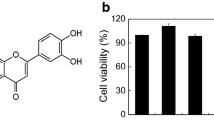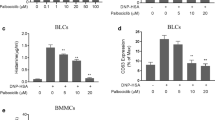Abstract
There is substantial evidence suggesting that the Ras inhibitor farnesylthiosalicylic acid (FTS) may modulate various aspects of immune function and inflammation in addition to its well known anti-cancer activity. In this regard, we have recently shown that FTS suppresses T lymphocyte-mediated immune responses. Mast cells (MC), the main effector cells in the elicitation of the allergic response, are known to secrete granule-associated mediators and to release prostaglandins and cytokines on FCεRI-cross-linking, thereby contributing to the pathogenesis of allergic diseases. We hypothesized that MC act as an additional target for FTS. In the present work we analyze the effects of FTS on MC degranulation, prostaglandin release, and cytokine release in vitro, and on the elicitation of IgE-mediated MC dependent cutaneous allergic inflammation in vivo. First we have established that FTS inhibited Ras activation in MC. Next, we have shown that FTS preferentially inhibited prostaglandin (PG) D2 and tumor necrosis factor (TNF)-α release without having any significant effect on MC β-hexosaminidase secretion. In vivo administration of FTS inhibited the late phase of passive cutaneous anaphylaxis reaction. The time course of FTS-induced inhibition in vivo correlated with mediators release and not with degranulation. This data suggests that FTS may have an inhibitory effect on MC mediated allergic inflammation, and thus may be considered as a possible therapeutic modality.



Similar content being viewed by others
Abbreviations
- FCεRI:
-
FC epsilon receptor I
- FTS:
-
Farnesylthiosalicylic
- GFP:
-
Green fluorescent protein
- GDP:
-
Guanosine diphosphate
- GTP:
-
Guanosine triphosphate
- MAPK:
-
Mitogen-activated protein kinases
- MC:
-
Mast cells
- PG:
-
Prostaglandin
- Ras:
-
Harvey rat sarcoma viral oncogene
- RFP:
-
Red fluorescent protein
- TNF:
-
Tumor necrosis factor
References
Blum, R., and Y. Kloog. 2005. Tailoring Ras pathway—inhibitor combinations for cancer therapy. Drug Resistance Update 8: 369–380.
Pando, R., I. Barshack, A. Raz, G. Luboshits, R. Haklai, S. Maysel-Auslender, Y. Kloog, G. Keren, and J. George. 2010. The Ras antagonist farnesylthiosalicylic acid ameliorates experimental myocarditis in the rat. Cardiovascular Pathology 19: 94–101.
Matcalfe, D.D., R.D. Peavy, and A.M. Gilfillan. 2009. Mechanisms of mast cell signaling in anaphylaxis. The Journal of Allergy and Clinical Immunology 124: 639–646.
Shefler, I., Y.A. Mekori, and A. Mor. 2008. Stimulation of human mast cells by activated T cells leads to N-Ras activation through Ras guanine nucleotide releasing protein 1. J Allergy Clin Immunol 122: 1222–5.
Baram, D., M. Rashkovsky, R. Hershkoviz, I. Drucker, T. Reshef, S. Ben-Shitrit, and Y.A. Mekori. 1997. Inhibitory effects of low molecular weight heparin on mediator release by mast cells: preferential inhibition of cytokine production and mast cell-dependent cutaneous inflammation. Clinical and Experimental Immunology 110: 485–491.
Sicherer, S.H., and D.Y.M. Leung. 2010. Advances in allergic skin disease, anaphylaxis, and hypersensitivity reactions to foods, drugs, and insects in 2009. The Journal of Allergy and Clinical Immunology 125: 85–97.
Mor, A., I. Shefler, P. Salamon, Y. Kloog, and Y.A. Mekori. 2010. Characterization of ERK activation in human mast cells stimulated by contact with T cells. Inflammation 33: 119–125.
Author information
Authors and Affiliations
Corresponding author
Additional information
Yoseph A. Mekori and Yoel Kloog contributed equally to this work.
Rights and permissions
About this article
Cite this article
Mor, A., Ben-Moshe, O., Mekori, Y.A. et al. Inhibitory Effect of Farnesylthiosalicylic Acid on Mediators Release by Mast Cells: Preferential Inhibition of Prostaglandin D2 and Tumor Necrosis Factor-α Release. Inflammation 34, 314–318 (2011). https://doi.org/10.1007/s10753-010-9236-x
Published:
Issue Date:
DOI: https://doi.org/10.1007/s10753-010-9236-x




